Good nutrition is the cornerstone of a healthy life for dogs, just as it is for humans. The well-being, vitality, and longevity of our canine companions heavily depend on the quality and balance of their diet.
As pet owners increasingly seek ways to enhance their dogs’ health through nutrition, the inclusion of organ meats in their diets has gained attention.
Organ meats, often referred to as offal, are rich in nutrients that are essential for a dog’s health but may be lacking in commercial pet foods or a strictly muscle-meat-based diet.
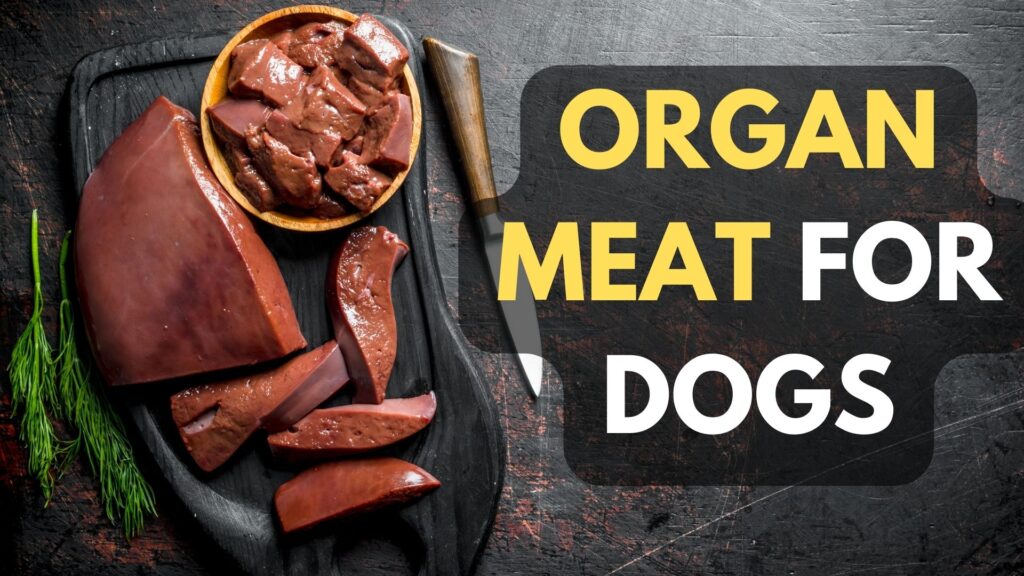
The trend towards feeding dogs a more “natural” diet mirrors the ancestral eating habits of wild canines, which consume almost all parts of their prey, including the organs.
This holistic approach to feeding is thought to provide a more complete nutritional profile, supporting various aspects of a dog’s health including their immune system, coat quality, and energy levels.
The growing interest among pet owners in providing such balanced and nutrient-rich meals signifies a shift towards prioritizing the health and natural dietary needs of dogs.
🥩The Nutritional Value of Organ Meats for Dogs
Organ meats are the internal organs and entrails of animals, and they are packed with a wide range of nutrients critical for a dog’s health.
These meats are considered superfoods in the canine world due to their high concentration of vitamins, minerals, and essential fatty acids.
For example, liver, one of the most nutrient-dense organ meats, is rich in vitamin A, vitamin D, several B vitamins, iron, copper, and zinc.
Kidneys are another excellent source of vitamins B12 and B2 (riboflavin), while hearts are loaded with taurine, an amino acid crucial for heart health, and CoQ10, a powerful antioxidant.
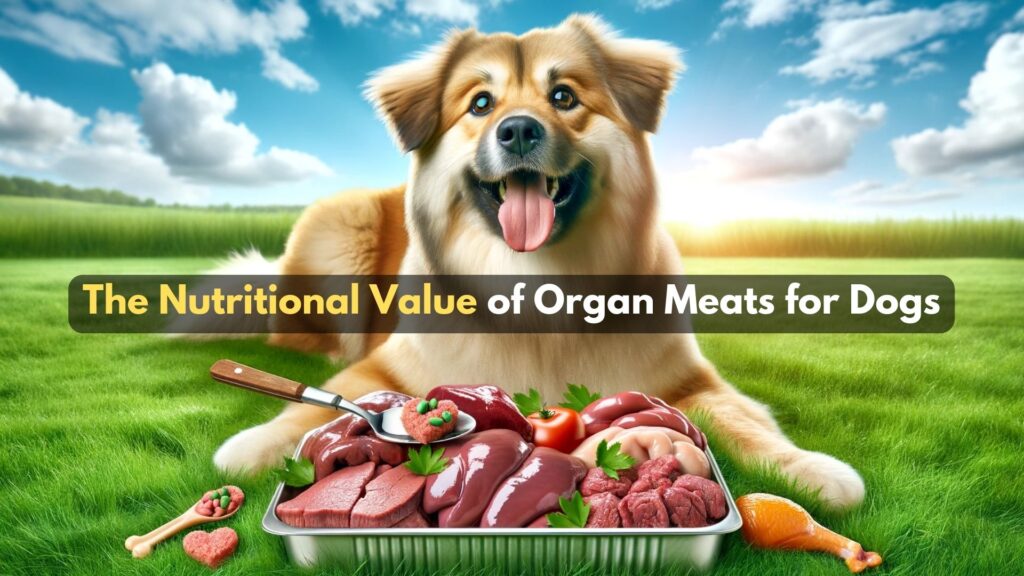
Here is a brief overview of common organ meats fed to dogs and their nutritional benefits:
- Liver: High in vitamin A, iron, and B vitamins, supporting vision, growth, and metabolism.
- Kidneys: Rich in selenium and B vitamins, aiding in detoxification and energy production.
- Heart: Packed with taurine and CoQ10, crucial for heart muscle function and energy.
- Tripe (stomach lining): Offers a balance of omega-3 and omega-6 fatty acids, aiding in digestion and promoting a healthy coat.
The concept of “whole prey” feeding is based on the idea of mimicking the natural diet of wild ancestors of dogs, who consumed not just the muscle meat but also the organs, blood, and bones of their prey.
This approach is believed to provide a more balanced and varied nutrient profile, reflecting a diet that dogs have evolved to thrive on. Including organ meats in a dog’s diet can enhance their nutritional intake, supporting overall health and preventing nutrient deficiencies.
By understanding the nutritional value and benefits of organ meats, pet owners can make informed decisions about incorporating these nutrient-rich foods into their dogs’ diets, contributing to their well-being and vitality.
🧐Identifying the Healthiest Organ Meats for Dogs
When it comes to feeding organ meats to dogs, not all organs are created equal. Each type of organ meat has a unique nutritional profile, offering different benefits and considerations for your dog’s diet.
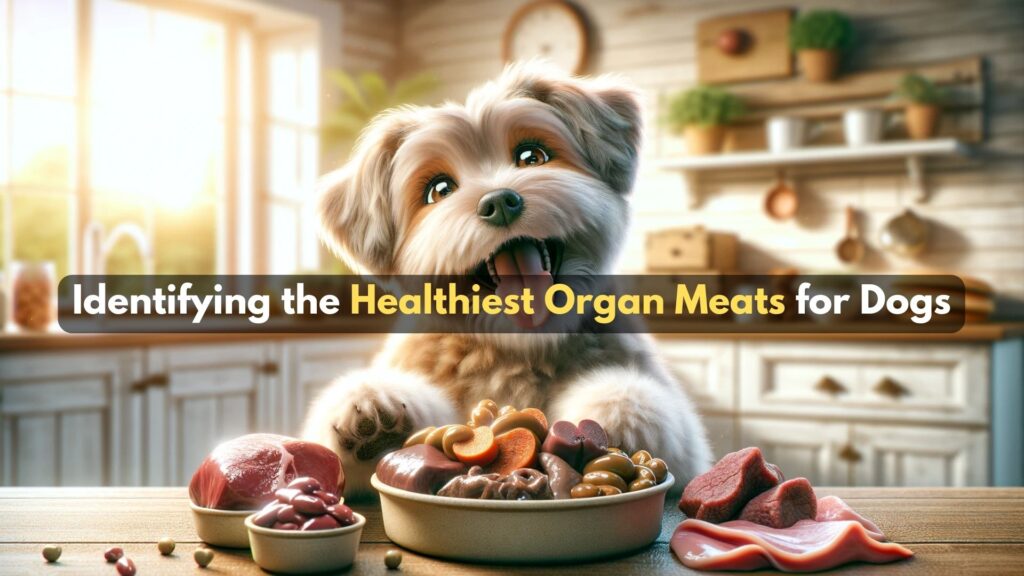
Here’s a detailed comparison of some of the healthiest organ meats:
Liver:
The liver is a powerhouse of nutrition, rich in vitamin A, essential for vision, growth, and immune function; B vitamins for energy metabolism; and iron for healthy blood.
However, because of its high vitamin A content, it’s essential to feed liver in moderation to avoid vitamin A toxicity, which can lead to serious health issues.
Kidneys:
Kidneys are another excellent choice, packed with selenium, a key antioxidant; B vitamins; and phosphorus, which supports kidney function and bone health.
Kidneys have a lower risk of causing vitamin overload and can be fed more regularly.
Heart:
The heart is less of an organ and more of a muscle meat, but it’s included here because of its high taurine and CoQ10 content.
Taurine is essential for cardiovascular health, and CoQ10 is a powerful antioxidant. The heart is considered a safe and healthy organ meat that can be fed regularly without the risk of vitamin toxicity.
Among these, the liver is often considered the most nutrient-dense but must be fed with caution due to the risk of vitamin A toxicity.
Kidneys and heart, on the other hand, provide essential nutrients with a lower risk of causing nutrient imbalances and can be fed more frequently.
How to Safely Introduce Organ Meats into Your Dog’s Diet
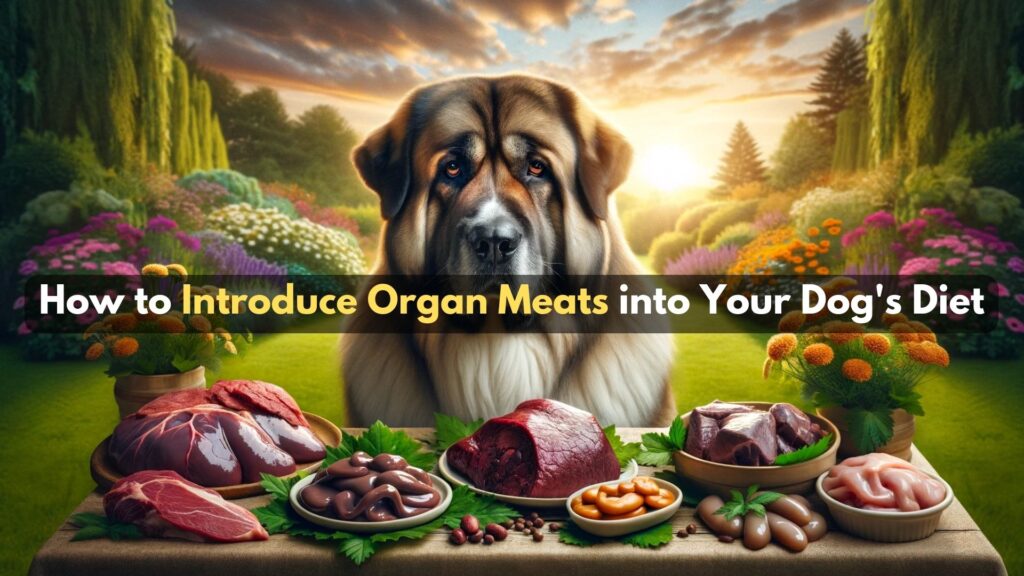
Guidelines on Portion Sizes and Frequency:
- Start with small amounts: Introduce organ meats gradually into your dog’s diet, starting with small portions (about 5% of their total diet) to avoid digestive upset.
- Maintain balance: Organ meats should not make up more than 10% to 15% of a dog’s overall diet. A balanced diet should also include muscle meats, bones (or a calcium supplement if feeding a boneless diet), and possibly some vegetables or other supplements, depending on the dog’s needs.
Sourcing High-Quality Organ Meats:
Look for fresh or frozen organ meats from reputable sources. Organic, grass-fed, and free-range options are ideal as they are less likely to contain hormones, antibiotics, or toxic substances.
Avoid processed or cooked meats intended for human consumption, as they can contain seasonings and additives that are harmful to dogs.
Preparation Methods:
- Raw feeding: Many advocates of raw feeding argue that raw organ meats preserve more nutrients. If you choose to feed raw, ensure the meat is fresh and handled with care to avoid contamination.
- Lightly cooking: For those concerned about potential pathogens in raw meats, lightly cooking organ meats (steaming or boiling) without any seasonings is a safe way to include them in your dog’s diet while still retaining most nutrients.
- Freeze-drying or dehydrating: Freeze-dried or dehydrated organ meats can be a convenient option, but ensure they are made specifically for dogs and do not contain any added salts or spices.
Introducing organ meats into your dog’s diet can significantly enhance their nutritional intake when done correctly. By following these guidelines, pet owners can safely provide their dogs with the health benefits of organ meats, contributing to their overall health and vitality.
Incorporating Organ Meats into a Balanced Diet
Organ meats play a crucial role in a balanced diet for dogs by providing a concentrated source of vitamins, minerals, and essential nutrients that are often more scarce in muscle meats alone.
However, the key to maximizing the benefits of organ meats while maintaining a healthy diet lies in variety and moderation.
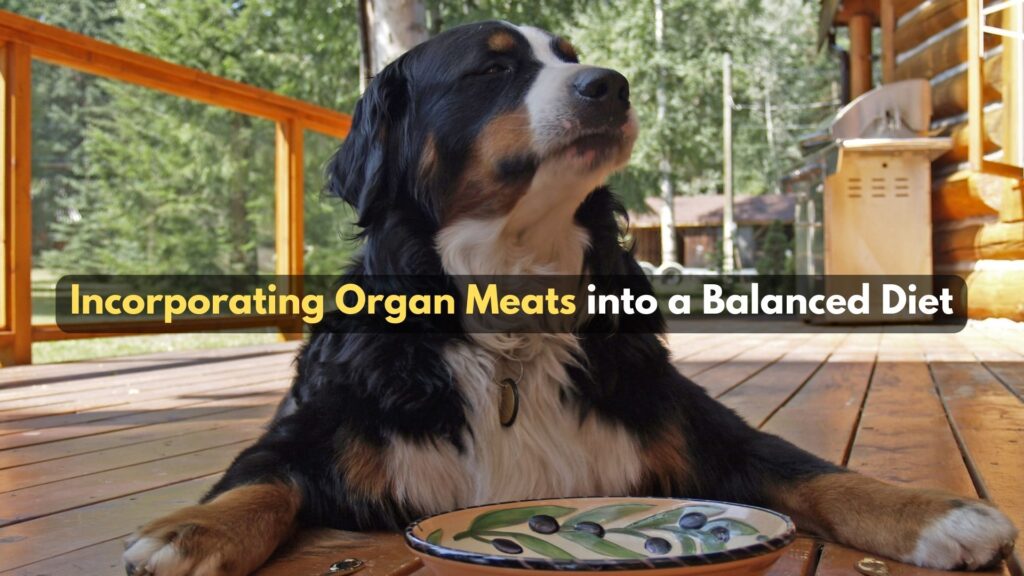
Balancing Organ Meats with Other Food Types:
- Muscle Meats: Should form the foundation of your dog’s diet, providing high-quality protein and essential fatty acids. Organ meats can complement muscle meats by providing the nutrients that muscle meats lack.
- Bones or Calcium Supplements: Raw or cooked bones (depending on your feeding philosophy) provide calcium and phosphorus, essential for bone and teeth health. If you’re not comfortable feeding bones, a balanced calcium supplement is necessary, especially in a raw diet.
- Vegetables: Some vegetables can be beneficial for dogs, offering fiber, vitamins, and minerals. However, they should be given in moderation and prepared appropriately (e.g., lightly steamed) for better digestion.
- Variety: Including different types of organ meats (liver, kidney, heart, etc.) alongside various muscle meats and safe vegetables ensures a broad spectrum of nutrients. This variety helps prevent both deficiencies and excesses of specific nutrients.
Importance of Variety and Moderation:
Incorporating a range of organ meats into your dog’s diet helps cover the spectrum of nutritional needs without risking nutrient imbalances.
Moderation is key to preventing issues like vitamin A toxicity from too much liver or avoiding potential sensitivities that might arise from overfeeding a single type of organ meat.
Common Concerns and Misconceptions

Debunking Myths:
| MYTH | FACT |
| Feeding organ meats is unhealthy for dogs. | Organ meats are highly nutritious and can be an essential part of a dog’s balanced diet when fed in appropriate amounts. |
| Organ meats will make dogs aggressive. | There is no scientific evidence to support the claim that diet influences a dog’s temperament in this way. Aggression is more likely related to genetics, environment, or lack of training. |
Addressing Common Concerns:
Allergies:
While allergies to organ meats are relatively rare, they can occur. Introduce new organ meats gradually and monitor your dog for any signs of allergic reactions, such as itching or gastrointestinal upset.
Digestive Issues:
Starting with small amounts and gradually increasing the portion size can help prevent digestive upset. If your dog shows signs of digestive distress, reduce the amount or frequency of organ meat feeding.
❓FAQs
Can organ meats be the sole component of my dog’s diet?
No, organ meats should not be the sole component of your dog’s diet.
While they are highly nutritious, a balanced diet for dogs should also include muscle meats, bones (or a calcium substitute), and possibly a small amount of vegetables or supplements to ensure all nutritional needs are met.
How often should I feed my dog organ meats?
Organ meats should comprise about 10% to 15% of your dog’s overall diet. They can be fed as part of a meal several times a week, depending on the rest of the diet’s composition.
It’s important to balance organ meat feeding with other diet components to avoid nutrient imbalances.
Are there any organ meats that should be avoided?
Most common organ meats like liver, kidneys, and heart are safe for dogs when sourced from healthy animals. However, it’s wise to avoid organs from wild game due to the risk of disease or contamination.
Additionally, brains should generally be avoided due to the risk of transmitting diseases such as BSE (mad cow disease).
How do I know if my dog is reacting badly to organ meats?
Signs that your dog might not be reacting well to organ meats include digestive upset (such as diarrhea or vomiting), itching, or lethargy. If you notice any adverse reactions, reduce the amount of organ meat or eliminate it from the diet and consult a veterinarian.
Can puppies eat organ meats?
Yes, puppies can eat organ meats, but in even smaller amounts than adult dogs. Because puppies have specific nutritional needs for growth and development, it’s essential to introduce organ meats slowly and in moderation, ensuring that their diet remains balanced.
📝Summary
In conclusion, organ meats offer a rich source of essential nutrients that can significantly enhance a dog’s diet, contributing to their overall health and vitality.
However, the key to incorporating organ meats into a dog’s diet lies in understanding their nutritional value, making informed choices regarding sourcing and preparation, and maintaining balance and moderation.
- Nutritional Value: Organ meats are nutrient-dense, providing vitamins, minerals, and essential fatty acids that are vital for your dog’s health.
- Informed Choices and Quality Sourcing: Choosing high-quality, fresh organ meats from reputable sources is crucial to maximize benefits and minimize risks.
- Moderation: While beneficial, organ meats should only make up a small portion of the diet, balanced with muscle meats, bones, and other diet components.
Remember: Before making significant changes to your dog’s diet, especially when introducing organ meats, it’s important to consult with a veterinarian.
A professional can provide guidance tailored to your dog’s specific health status and nutritional needs, ensuring that your dog benefits fully from the inclusion of organ meats in their diet.



0 Comments